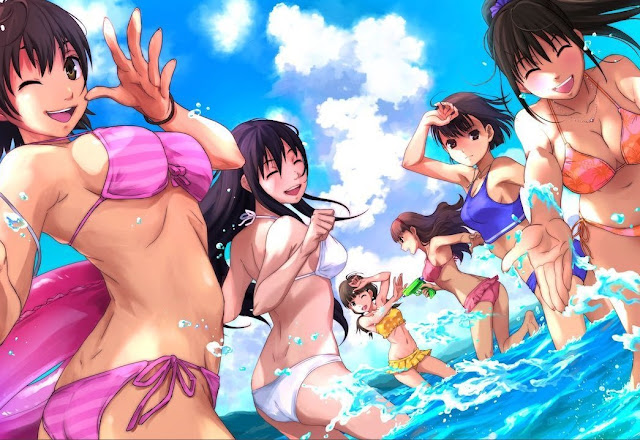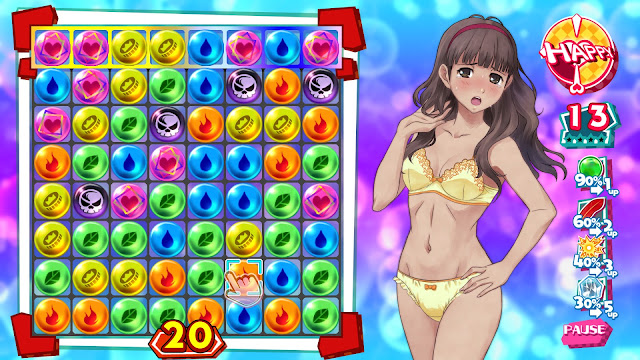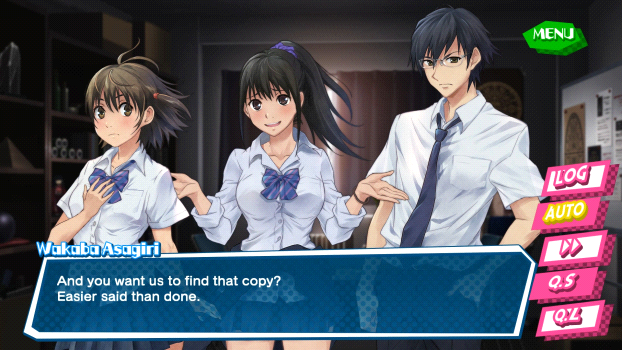Interview by Matt S.
Kotodama: The 7 Mysteries Of Fujisawa releases tomorrow, and it’s a big deal for publisher PQube, as it also happens to be the first game that PQube has developed. Taking that step from publishing games for other developers to creating one in-house is a huge one, and the stakes are high for the company.
For this big first outing, the team have done exactly what you would expect from PQube – they’ve created a fanservicey visual novel that combines charming, bright characters and plenty of humour with some match-3 puzzle action. And underwear. Oh, so much underwear.
We’ll have a full review of the game up on DDNet in time for its release tomorrow. In the meantime, we had the chance to chat with Amaria Larchet, the producer of the game, on what she and her team were looking to achieve with Kotodama, why go with the visual novel as a first title, and, of course, where the stunning lingerie designs came from.
Digitally Downloaded (DD): Where did the inspiration for Kotodama come from?
Amaria Larchet (AL): The story and the general setting of the game are the result of many discussions we had with the studio Art. The idea was to work on a story that would surprise the players.
Slice of life anime or manga set in school typically involve comedic or romantic elements but not necessarily darker or unsettling themes, so we decided to use a similar setting. I hope people who will start playing Kotodama thinking it’s a casual and light-hearted story (which it also is!) will be pleasantly surprised by the turn of events.
The goal, ultimately, was for people to see the key art, the art style and play the opening moments and be confident that the story will play out one way, and then, when they get to the end think “well, I wasn’t expecting that!”
DD: Why blend the match-3 puzzler and visual novel genres together? What’s this game going to offer players?
AL: The story of Kotodama revolves around a character who has a special ability that grants him/her the power to see through the lies of people. The match-3 puzzles are a sort of manifestation of this power.
Quite early on, we decided to have a normal adventure mode that plays like a classic visual novel, and something more interactive that would make the story progress. I think it’s quite satisfying to be able to confront the character that has been lying to you during the whole chapter! We wanted a puzzle that could be enjoyed on its own and that would make players want to come back. We eventually decided to use a match-3 puzzle as a basis, something that many players are already familiar with but with our own twist! We added undressing and interactive mechanics.
At the same time, we didn’t want the puzzle game to be too intrusive – we wanted players to enjoy a VN first and foremost and then look forward to the battles when they occur as a way of adding something interesting to the flow of the story.
DD: It seems that Kotodama is going to have some some heavy fan service elements – what does that add to the game?
AL: When we were working on the concept of Kotodama, we thought about what we liked in the Japanese games that we’ve been playing. Fan service is present in a variety of Japanese games, it often makes people go “Oh Japan” but if you’re familiar with some of our other games (Gal*Gun, or more recently Punch Line), you might know that we’re not against this sort of thing!
That said we didn’t want the fan service element to dictate the atmosphere of the game, rather, we wanted to add a layer of humour and self-awareness into the mix. Kotodama’s fan service is silly and sometimes over-the-top but it doesn’t take away from the game and the main story.
DD: From the description of the game: Nothing is as it seems! Kotodama intentionally plays on classic tropes and clichés to continually twist the story and surprise the player. – Does that mean it’s going to be subversive to the anime + fan service “genre?” Is it satirical in tone? Critical? I’m very keen to know what form this surprise will take!
AL: We have used some of the Japanese anime tropes while thinking of events or behaviours that we wouldn’t typically expect from them. It is not a satire of the visual novel genre, but it definitely plays with some of the more common anime tropes.
As the main goal was to surprise the player, we wanted to take elements that anime or VN or manga fans would recognise and then, at points, change it up so the characters are different from what people would expect from these archetypes.
DD: Are there any particular film/ literature sources of inspiration for Kotodama? Can you give me an overview for how the narrative was developed?
AL: If you have played the Phoenix Wright series, you may remember some of the characters’ breakdowns at the end of the trials? The unexpectedness was what was truly memorable to me. We wanted to find to find ways to catch the player by surprise.
We quickly considered developing a seemingly light-hearted story with revelations that would surprise the players once they progressed through the game. A way to do so was to have a plot that would revolve around a character investigating something with unexpected outcomes.
We decided to have several mysteries, each revolving around different characters and revelation.
It’s something that we already had in mind when creating the characters, so the secrets were for the most part already written. Once we all agreed on the flow of the chapters, we have started working on the script.
Likewise, we like to think of Fujisawa Academy as a character in its own right. While individual characters have their secrets – some serious, some silly, we began to think of Fujisawa Academy as a mystery in and of itself. This is no normal establishment, but when you start playing, we want players to feel that the place is normal for the genre.
DD: I love the character designs! Was there any particular process that you went through in building these characters?
AL: Thank you! For the characters, we have many visual novel and anime fans in our teams, so it’s a bit of a mash-up of different things we liked. For example, one of the inspirations for one of the characters was Kanade from the anime Castle Town Dandelion (can you guess which one?).
Once the concept of the character had been discussed and reviewed by both sides, Art would send us the first sketches. We would give our feedback until everyone was pleased with their final design, including their underwear too!
Everyone on the team has their Best Boy or Best Girl, we like to think there’s a little of all of our tastes in the game!
DD: Are there plans on turning this into a series – sequels, spin-offs?
AL: We would sure love to! While we can’t go into too much detail right now – we have already planned out what the Kotodama universe would involve. There are the beginnings of a much bigger story arc there – and some of this is hinted at in Kotodama; The 7 Mysteries of Fujisawa. What is the nature of the relationship between Mon-Chan and the player for example? We’ve also grown to love our characters and it would be wonderful to be able to explore what happens to some of the cast next. There is quite a lot of back-story that we couldn’t convey, we wanted to concentrate on the main events and not run the risk of losing focus – but also hint that there’s more to be told.
I guess ultimately future games will rely on the success of our first game. For PQube this is a big step forward for us – developing our own title from scratch has been a massive learning curve. We really hope our fans can get behind us, enter into the spirit of this first game and, all being well, help us to a point where the next chapter in the story is viable. We’ve already received so much support for this project, and for that we are extremely thankful.
DD: What do you think is behind the rapid growth of popularity in visual novels in the west over the last decade or so?
AL: Even if it was niche, I think there always has been an interest for Japanese visual novels in the West, with obviously less means of access to them. Lots of fan translations were circulating for visual novels on PC, but we’ve seen progressively more publishers localising projects on consoles which led to even more people having access to them.
Handheld consoles also have played a big role in popularising the genre. The portable format is perfect for long sessions of reading, and it’s why the PlayStation Vita was such a good platform for visual novels. Other adventure games with visual novel elements were also very popular on the Nintendo DS, and now naturally on Nintendo Switch. We are releasing our games on different platforms but for visual novels, it’s quite clear that the Switch is the preferred platform overall.
DD: What makes a good VN, from your perspective?
AL: To me, the most important part is probably the general atmosphere of the game. It’s true for other genres as well but it’s something that would make me think of the game even when I’m not playing. It can be difficult to work on since it relies on different elements (music, art style, the rhythm) but a lot can be done through the tone of the texts and dialogues.
The flow is also really important. You have to keep an eye on the text more or less all the time and no one likes to get bored skipping endless scenes.
Not that there is a perfect recipe, but I often prefer when character development scenes or moments of humor are fully integrated into the story progression chapters. They can sometimes be approached as two separate things, but it doesn’t always work for me. When I really want to know what is going to happen, I don’t like when I’m thrown into what could be felt like a filler chapter. The flow of the game should be as natural as possible.
DD: Finally, what games are you playing at the moment, and what are your thoughts on them?
AL: I am on a quest to finish my back catalogue. I tend to restart games when I haven’t played them for a while so it may very well never happen, but I am on Persona 3 FES (PS2) at the moment. The battle system is a bit tricky compared to the remake on PSP or even Persona 5 but it’s such a good game! Game overs often seem unfair but for some reason, they always make me want to try again.
I think it will keep me busy for a while.
– Matt S.
Editor-in-Chief
Find me on Twitter: @digitallydownld
Please help keep DDNet running: Running an online publication isn’t cheap, and it’s highly time consuming. Please help me keep the site running and providing interviews, reviews, and features like this by supporting me on Patreon. Even $1/ month would be a hugely appreciated vote of confidence in the kind of work we’re doing. Please click here to be taken to my Patreon, and thank you for reading and your support!













